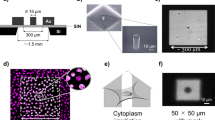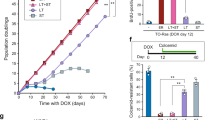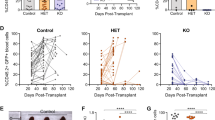Abstract
The accumulation of DNA repair proteins at the sites of DNA damage can be visualized in mutagenized cells at the single cell level as discrete nuclear foci by immunofluorescent staining. Formation of nuclear foci in irradiated human fibroblasts, as detected by antibodies directed against the DNA repair protein MRE11, is significantly disturbed by the presence of the viral oncogene, SV40 large T-antigen. The attenuation of foci formation was found in both T-antigen immortalized cells and in cells transiently expressing T-antigen, indicating that it is not attributable to secondary mutations but to T-antigen expression itself. ATM-mediated nibrin phosphorylation was not altered, thus the disturbance of MRE11 foci formation by T-antigen is independent of this event. The decrease in MRE11 foci was particularly pronounced in T-antigen immortalized cells from the Fanconi anaemia complementation group FA-D2. FA-D2 cells produce essentially no MRE11 DNA repair foci after ionizing irradiation and have a significantly increased cellular radiosensitivity at low radiation doses. The gene mutated in FA-D2 cells, FANCD2, codes for a protein which also locates to nuclear foci and may, therefore, be involved in MRE11 foci formation, at least in T-antigen immortalized cells. This finding possibly links Fanconi anaemia proteins to the frequently reported increased sensitivity of Fanconi anaemia cells to transformation by SV40. From a practical stand point these findings are particularly relevant to the many studies on DNA repair which exploit the advantages of SV40 immortalized cell lines. The interference of T-antigen with DNA repair processes, as demonstrated here, should be borne in mind when interpreting such studies.
This is a preview of subscription content, access via your institution
Access options
Subscribe to this journal
Receive 50 print issues and online access
$259.00 per year
only $5.18 per issue
Buy this article
- Purchase on Springer Link
- Instant access to full article PDF
Prices may be subject to local taxes which are calculated during checkout





Similar content being viewed by others
References
Bhattacharyya A, Ear US, Koller BH, Weichselbaum RR, Bishop DK . 2000 J. Biol. Chem. 275: 23899–23903
Bressan DA, Baxter BK, Petrini JH . 1999 Mol. Cell. Biol. 19: 7681–7687
de Jager M, Dronkert ML, Modesti M, Beerens CE, Kanaar R, van Gent DC . 2001 Nucleic Acids Res. 29: 1317–1325
Digweed M, Reis A, Sperling K . 1999 BioEssays 21: 649–656
Digweed M, Rothe S, Demuth I, Scholz R, Schindler D, Stumm M, Grompe M, Jordan A, Sperling K . 2002 Carcinogenesis 23: in press
Dosik H, Hsu LY, Todaro GJ, Lee SL, Hirschhorn K, Selirio ES, Alter AA . 1970 Blood 36: 341–352
Garcia-Higuera I, Taniguchi T, Ganesan S, Meyn MS, Timmers C, Hejna J, Grompe M, D'Andrea AD . 2001 Mol. Cell 7: 249–262
Gatei M, Young D, Cerosaletti KM, Desai-Mehta A, Spring K, Kozlov S, Lavin MF, Gatti RA, Concannon P, Khanna K . 2000 Nat. Genet. 25: 115–119
Joenje H, Patel KJ . 2001 Nat. Rev. Genet. 2: 446–457
Kanaar R, Hoeijmakers JH, van Gent DC . 1998 Trends Cell Biol. 8: 483–489
Lanson Jr NA, Egeland DB, Royals BA, Claycomb WC . 2000 Nucleic Acids Res. 28: 2882–2892
Liu JM, Poiley J, Devetten M, Kajigaya S, Walsh CE . 1996 Biochem. Biophys. Res. Commun. 223: 685–690
Lubiniecki AS, Blattner WA, Dosik H, McIntosh S, Wertelecki W . 1980 Am. J. Hematol. 8: 389–396
Maser RS, Monsen KJ, Nelms BE, Petrini JH . 1997 Mol. Cell. Biol. 17: 6087–6096
Nelms BE, Maser RS, MacKay JF, Lagally MG, Petrini JH . 1998 Science 280: 590–592
Paull T, Cortez TD, Bowers B, Elledge SJ, Gellert M . 2001 Proc. Natl. Acad. Sci. USA 98: 6086–6091
Saintigny Y, Lopez BS . 2002 Oncogene 21: 488–492
Schultz LB, Chehab NH, Malikzay A, Halazonetis TD . 2000 J. Cell Biol. 151: 1381–1390
Scully R, Chen J, Ochs RL, Keegan K, Hoekstra M, Feunteun J, Livingston DM . 1997 Cell 90: 425–435
Tashiro S, Walter J, Shinohara A, Kamada N, Cremer T . 2000 J. Cell Biol. 150: 283–291
Todaro GJ, Green H, Swift MR . 1966 Science 153: 1252–1254
Varon R, Vissinga C, Platzer M, Cerosaletti KM, Chrzanowska KH, Saar K, Beckmann G, Seemanova E, Cooper PR, Nowak NJ, Stumm M, Weemaes CM, Gatti RA, Wilson RK, Digweed M, Rosenthal A, Sperling K, Concannon P, Reis A . 1998 Cell 93: 467–476
Wang Y, Cortez D, Yazdi P, Neff N, Elledge SJ, Qin J . 2000 Genes Dev. 14: 927–939
Zhu JY, Abate M, Rice PW, Cole CN . 1991 J. Virol. 65: 6872–6880
Acknowledgements
We are indebted to Dr Monika Grässmann, Free University Berlin, for the SV40 T-Ag expression plasmid and to Dr Kenshi Komatsu, Hiroshima University, Japan, for the SV40 immortalized NBS cell line, GM166VA7. Excellent technical assistance was provided by Gabriele Hildebrand and Janina Radszewski, for which we are grateful. This work was supported by the Fritz-Thyssen-Stiftung (Az 2000/01/69) and the Deutsche Forschungsgemeinschaft (SFB 577-B1).
Author information
Authors and Affiliations
Corresponding author
Rights and permissions
About this article
Cite this article
Digweed, M., Demuth, I., Rothe, S. et al. SV40 large T-antigen disturbs the formation of nuclear DNA-repair foci containing MRE11. Oncogene 21, 4873–4878 (2002). https://doi.org/10.1038/sj.onc.1205616
Received:
Revised:
Accepted:
Published:
Issue Date:
DOI: https://doi.org/10.1038/sj.onc.1205616
Keywords
This article is cited by
-
The interactions between PML nuclear bodies and small and medium size DNA viruses
Virology Journal (2023)
-
Molecular mechanisms of pluripotency and reprogramming
Stem Cell Research & Therapy (2010)
-
Human SNM1B is required for normal cellular response to both DNA interstrand crosslink-inducing agents and ionizing radiation
Oncogene (2004)



